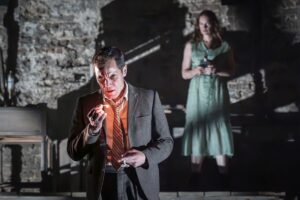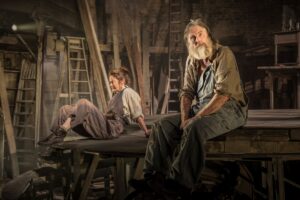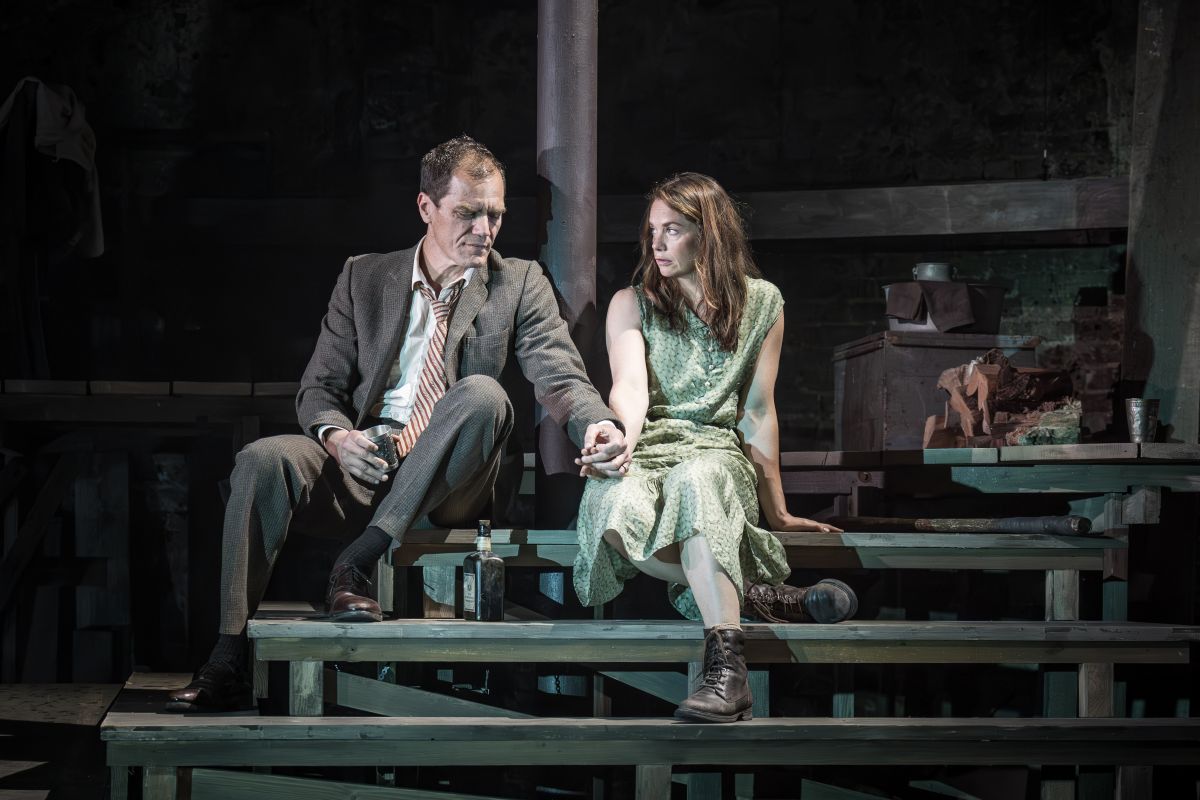Rebecca Frecknall delivers a lucid and emotionally charged revival of Eugene O’Neill’s late masterpiece.
A Moon for the Misbegotten returns us to the haunted emotional terrain of Eugene O’Neill’s America — a world where loneliness, guilt, and unfulfilled love quietly dominate lives. A companion piece to Long Day’s Journey Into Night, this late work is less explosive but no less piercing. At the Almeida, it’s rendered with care, control, and remarkable emotional intelligence.
The story revolves around three characters — Josie Hogan, her father Phil, and Jim Tyrone Jr. — all held fast by the weight of the past. Frecknall gives each one space to reveal not only their own sorrows but how deeply their identities are bound up in each other.
Ruth Wilson leads as Josie, the Irish-American farmer’s daughter whose fierce wit and coarse humour conceal deep empathy and longing. Though O’Neill described Josie as physically ‘overgrown, ungainly, big-boned woman’ , Wilson — a striking presence — makes that detail irrelevant. She doesn’t play against type; rather, she reframes the role entirely. Her Josie is emotionally exposed, intuitively strong, and often disarmingly kind beneath the bravado. The love between Josie and Jim is not romantic in the traditional sense; it is rooted in mutual understanding and need. She offers him a kind of steadiness — almost maternal — and he clings to it even as he cannot receive it fully. Wilson’s performance reveals a woman shaped by disappointment but still capable of astonishing emotional generosity.
Michael Shannon, as Jim Tyrone Jr., gives a subdued and affecting performance. At first glance, Jim may seem the least engaging of the trio — his humour doesn’t land, and he often appears emotionally flat. But this is the point. Shannon reveals a man numbed by grief, alcohol, and a lifetime of self-rejection. His tragedy is internalised. He cannot fully accept Josie’s love, not because he doesn’t feel it, but because he no longer believes he deserves anything real. His inherited wealth is meaningless against such emotional poverty. Their long scene together, spent largely in stillness and half-spoken truths, becomes the quiet heart of the play.

In the first half, the characters often skirt around their true emotions, masking vulnerability with raised voices, teasing, or confrontation; but as the night deepens, the emotional tone shifts — becoming quieter, more reflective, and at times, painfully honest.
David Threlfall, as Phil Hogan, is a force in the first half of the play — dominating the stage with quick-fire wit, irreverence, and a comic timing that extracts every ounce of humour from O’Neill’s script. But this is no caricature. Threlfall layers his performance with teasing affection, needling sarcasm, and flashes of insight that hint at the deeper emotional life beneath the bluster. His relationship with Josie is complex: protective, provoking, at times exasperating, but undeniably loving. His delivery of the line, “never trust anyone too far, not even myself,” is both self-aware and weary — the philosophy of a man shaped by hardship and survival, yet still capable of empathy. In many ways, Phil’s expansive energy sets the emotional stage for what follows, making his presence essential not just as comic relief, but as an emotional anchor.

Tom Scutt’s set design, in collaboration with Jack Knowles’s poetic lighting, Moi Tran’s naturalistic costumes, and Peter Rice’s subtle soundscape, creates a space that is both spare and emotionally resonant. A semi-circle of exposed brick, with several ladders leaning against the back wall, evokes lives suspended — dreams reaching nowhere. One detail quietly anchors the emotional terrain: the wooden steps leading to Josie’s bedroom, fully visible and actively used. Josie ascends them to “make myself beautiful,” adding, with typical self-mocking humour, “As if that was possible!” Jim later hides there, silently observing a comic scene unfold, and Phil enters in the final act just before Jim wakes from sleep. This space isn’t abstract — it feels lived-in, tenderly charged. It becomes a place of retreat, of quiet preparation, and of unspoken longing.
Even the minor characters — Josie’s brother Mike (Peter Corboy) and neighbour T. Stedman Harder (Akie Kotabe) — contribute meaningfully. Mike’s exit underscores Josie’s entrapment; Harder, awkward and somewhat pompous, who is disliked and mocked by the Hogans, reveal class tensions and the family’s hard-won self-possession.
Some moments in Part I may feel slow, but the pacing is carefully judged. That early stillness creates the emotional landscape in which the rest of the play unfolds. Rather than being trimmed, it earns its weight through atmosphere and dramatic rhythm.
When I attended, the theatre was filled with young people, many clearly absorbed, moved, and even amused. This revival demonstrates how timeless O’Neill’s characters are — vulnerable, complex, and achingly human. Frecknall has not modernised O’Neill. She has simply trusted the material — and her cast — to speak clearly. The result is theatre that resonates not through spectacle, but through humanity.
By Eugene O’Neil
Director: Rebecca Frecknall
Cast includes: Cast includes: Ruth Wilson, Michael Shannon, David Threlfall, Peter Corboy and Akie Kotabe.
Set design: Tom Scutt
Costume Designer: Moi Tran
Running Time: Approx. 3 hours including an interval.
Until: Sat 16 Aug 2025
Photo credit: Marc Brenner

